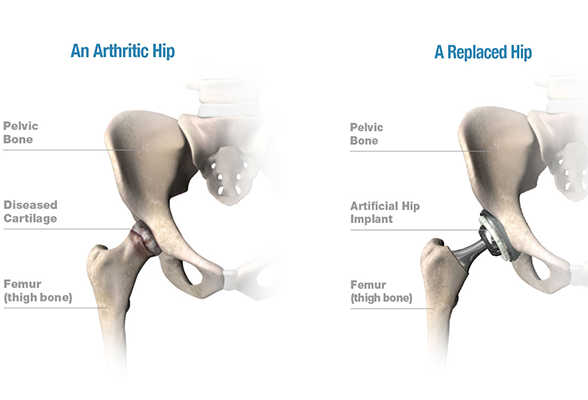Hip Arthritis & Management
What is the Hip Joint?
The hip joint is a ball and socket joint which links the pelvis with the upper end of the thigh bone. The ball is on the upper end of the thigh bone and this fits into a socket which is on the outer part of the pelvis.
Arthritis
A smooth, slippery, fibrous connective tissue called articular cartilage acts as a protective cushion between bones inside the joint. Arthritis develops as the cartilage begins to deteriorate or is lost because of wear and tear as part of aging or because of disease like Rheumatoid arthritis. As the articular cartilage is lost, joint space between the bones become narrow. This is an early sign of arthritis and is easily seen on X-Rays. Slowly over time bone ends rub against each other and wear away. This results in progressive pain and shortening. Normal activity becomes painful and difficult. Pain can even interfere with simple daily activities. Common arthritis symptoms include pain, stiffness, some loss of joint motion, deformity, limp and shortening of limb
Who develops arthritis?
- Primary osteoarthritis typically affects patients over 50 years of age, but is uncommon in India
- It is more common in persons who are overweight, or suffering from Rheumatoid arthritis or Ankylosing spondylitis. In some patients arthritis tends to run in families.
- Other factors that can contribute to developing hip arthritis include injury to the hip (Acetabulum fracture or after fracture neck of femur), developmental abnormalities like dysplastic hip and Perthe disease
What is the treatment of Hip arthritis?
- Conservative treatment does not have a significant role in management, once hip arthritis has set in.
- Initial treatment includes medications for pain relief, weight control and physical therapy.
- If all these fail to produce satisfactory response, one should consider hip replacement as the last resort treatment.
Who need a Hip Replacement?
If your answer is yes to most or all the questions, you probably are a candidate for Hip replacement surgery.
- Does severe hip pain limit your activities? (walking, climbing stairs, getting in and out of chair)
- Is your Hip stiff, which makes it difficult to move or your hip is fixed in one position?
- Pain associated with limb shortening and limp while walking

Procedure
Hip joint is exposed using a incision on the back of hip, over the buttock. Joint is exposed after separating the muscle and cutting through the capsule. The worn and damaged surface of bone and cartilage from upper end of femur (thigh bone) and pelvis are removed and shaped to accept the prosthetic implants. These surfaces are replaced with metal and plastic / Ceramic implants which closely mimic natural hip motion and function.
Realistic expectations
- Ultimate goal of hip replacement surgery is pain relief and improved function.
- Hip replacement surgery will not treat pain arising from other joints or back. Although some improvement is expected because of improve gait or walking pattern.
- Restrictions like avoiding running, high impact aerobics and sports like tennis are to be practiced for rest of life.
- Extreme bending, squatting and sitting cross-leg should be avoided to prevent dislocation and wear or early loosening of implants.
- Hip replacements last many years, but may need revision surgery when they wear out or loosen.
Points to remember after total Hip surgery
After Hip replacement, certain important aspects of your recovery need to be kept in mind:
- Walking and limited post-op exercises are important and should be performed as instructed by your physiotherapist. These have to be continued lifelong.
- Balance rest and activity, especially early in your recovery.
- Follow instructions to prevent clots.
- Know the signs of infection.
- Be careful and avoid falls.
- Carefully adhere to restrictions.
- Specific precautions to prevent dislocation of hip are available as separate documents.
Risks of not having Surgery
Getting ready for the surgery
As with all operative endeavors, there is a list of potential pitfalls, problems or complications. To name a few there is risk of Infection, clots forming in the veins of the leg travelling off to the heart and lungs, Pneumonia, Nerve Injury, compartment syndrome and loosening. All the necessary precautions are observed to minimize the risk of complications.

Dr. Aman Dua
M.S. Orthopedics (AIIMS, New Delhi), D.N.B. Orthopedics,
M.N.A.M.S., P.G.D.H.M.
Director - Joint Replacement
Fortis Escorts Hospital, Delhi




